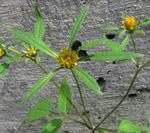| Home | About BFIS | Species List | Risk Analysis | Harmonia⁺ | Resources | Outputs | Mailing List | Registry |
| Contact us | Login | | ||||||
 |
 Naturalization in Belgium Naturalization in Belgium
 Invasiveness Invasiveness
More on invasiveness: Bidens frondosa is an annual pioneer species of moist grounds; it colonises river banks, mud flats, ditches, ponds and other open alluvial habitats. Central achenes are morphologically adapted for long-distance dispersal by animals while fast-germinating peripheral ones have a lower dispersal capability.
 Distribution in Belgium Distribution in Belgium
Established populations

Endangered areas

 Impacts on Species Impacts on Species
 Impacts on Ecosystems Impacts on Ecosystems
More on impacts: Dense stands of Bidens frondosa are likely to affect pioneer vegetation, namely the native Bidens tripartita and other pioneer nitrophilous plant species typical of muddy river banks. However, impacts on native vegetation seems to be rather limited and have not been well documented in the scientific literature.
References:
AEF (2006)
Cartes provisoires de la distribution de néophytes en Wallonie.
Unpublished document.
Brändel, M. (2004)
Dormancy and germination of heteromorphic achenes of Bidens frondosa.
Flora - Morphology, Distribution, Functional Ecology of Plants 199(3): 228-233.
Kasperek, G. (2004)
Fluctuations in numbers of neophytes, especially
Impatiens glandulifera , in permanent plots in a west German floodplain during 13 years.
 In: Kühn, I.& Klotz, S. (Eds.), Biological Invasions: Challenges for Science. NEOBIOTA 3: 27-37.
Lambinon, J., Delvosalle, L. & Duvigneaud, J. (2004)
Nouvelle fore de la Belgique, du Grand-Duché de Luxembourg, du Nord de la France et des régions voisines.
Editions du Patrimoine du Jardin botanique national de Belgique, Meise.
Muller, S. (2004)
Plantes invasives en France : état des connaissances et propositions d'actions.
Publication scientifique du Museum d'Histoire naturelle, Patrimoines naturels n°62.
Toussaint, B. & Bedouet, F. (2005)
Agence de l'Eau Artois-Picardie, 38 pp.
Toussaint, B., Mercier, D., Bedouet, F., Hendoux, F. & Duhamel, F. (2008)
Flore de la Flandre française
Centre régional de phytosociologie agréé Conservatoire botanique national de Bailleul.
Van Landuyt, W., Hoste, I., Vanhecke, L., Van den Bremt, P. Vercruysse, W. & De Beer, D. (2006)
Atlas van de Flora van Vlaanderen en het Brussels gewest.
Nationale Plantentuin en het Instituut voor Natuur- en Bosonderzoek i.s.m. Flo.Wer vzw.
Verloove, F. (2006)
Scripta Botanica Belgica 39, 89 pp.
|
 |
 |










